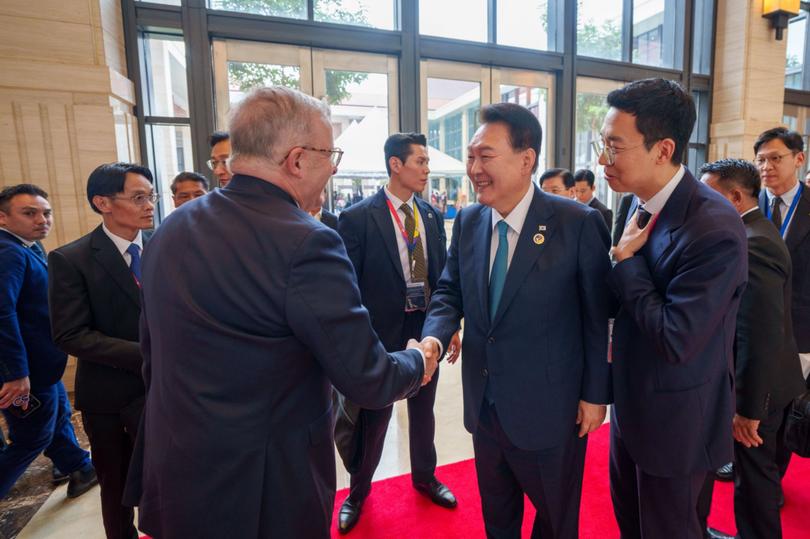ISABELLE MULLEN: Careful conversation is our best weapon against an increasingly belligerent China

South-East Asia is known for its good food, rugged beauty, and as a destination for a cheap holiday.
But the Federal Government would like it to be much more.
Anthony Albanese has just returned from Laos, after looking to shore up two-way trade with the region.
Sign up to The Nightly's newsletters.
Get the first look at the digital newspaper, curated daily stories and breaking headlines delivered to your inbox.
By continuing you agree to our Terms and Privacy Policy.His trip is a strategic move as much as it is about trade and the economy.
The Prime Minister is trying to reduce our dependence on China after it slapped more than $20 billion worth of trade restrictions on Australian exports like wine, barley, and lobster back in 2020.
But having tough conversations in Laos — with China present — is a strange dynamic.
Sitting in the middle of South-East Asia, Laos is surrounded by conflicting politics.
Communist party flags — with a hammer and sickle — hang in the street.
Laos is interesting because it has both communist and democratic neighbours, sharing borders with China, Myanmar, Thailand, Cambodia, and Vietnam.
From its capital Vientiane you can see Thailand across the Mekong River.
Countries here have conflicting feelings about China.

Last week, world leaders came together in Laos for the Association of Southeast Asian Nations Summit.
China was present as a dialogue partner.
The East Asia Summit ran alongside ASEAN, which meant the United States and Russia were there too.
There are only a few opportunities for competing superpowers like the US and China to sit down together and air their grievances in a diplomatic setting.
That’s the aim of the summit.
ASEAN was established in 1967 in response to the rising threat of communism and was designed to “promote regional peace and stability through abiding respect for justice and the rule of law”.
But in a world where China seems to do what it wants, when it wants, ASEAN is under increasing pressure to prove its relevance.
Particularly as China ramps up its aggression in the South China Sea.
Beijing has been accused of “dangerous and unlawful” conduct towards Filipino and Australian defence personnel in the highly contested trade route.
In recent months, China has used its military to push the Philippines out of strategically important islands and reefs.
Vietnam’s state media says one of their fishing crews was injured in an attack by China, with 10 crew members reportedly suffering broken limbs.
This year, China has also tested ballistic missiles over the Pacific, sparking protests from neighbouring countries.
So, with this in mind you’d imagine it could have been awkward for Mr Albanese to sit between Chinese Premier Li Qiang and the President of the Philippines Bongbong Marcos at the ASEAN summit.
He was in a tough position.
China had only just agreed to lift one of its last remaining tariffs on Australian rock lobster by the end of the year.
The Prime Minister is caught between trying to please our largest trading partner while supporting a strategic ally — the Philippines.
So, what’s the point of ASEAN if not to stamp out dangerous interactions with China?
Trade is part of the answer.
China has been ASEAN’s largest trading partner since 2009, with two-way trade now worth more than $722 billion.
South-East Asian economies are currently dependent on China for two-way trade.

So, their relationship with Beijing — like ours — is complicated.
It’s complicated further by a melting pot of allegiances; most South-East Asians now say they’d choose China over the US as their preferred superpower.
This year, a survey by a Singapore-based think-tank found more than half would prefer to align with Beijing over Washington.
China is without question the most influential economic power in the region.
Its trade in South-East Asia was taking place before the Portuguese captured the Melaka in 1511.
China is also our largest trading partner, but the Federal Government wants to create other opportunities, so Australian producers aren’t at the mercy of Beijing’s whims.
Our special envoy for South-East Asia Nicholas Moore says our “economic destiny lies in southeast Asia”.
He’s developed a national strategy for greater trade and investment; Australia’s Southeast Asia Economic Strategy to 2040.
Diversifying our trade partnerships is important to both Australian producers and to our allies: the United States, Japan, the Republic of Korea, the Philippines, and Thailand.
In an environment of growing global uncertainty and apparent aggression from China, the argument for ASEAN is that China meets with world leaders that it might otherwise avoid.
Critics may say the summit is redundant, but at least Beijing has agreed to take our lobster again.
Isabelle Mullen is a political reporter for 7NEWS
